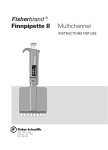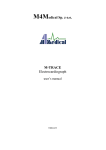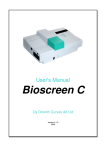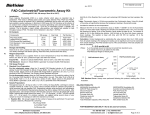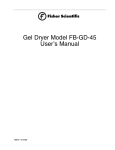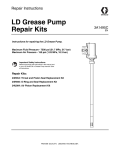Download Fisherbrand II Single Channel User Manual 2002
Transcript
Fisherbrand ® Finnpipette II Digital R Fisherbrand Finnpipette® 10.0 Finnpipette® 1.0 0 Fisherbrand R INSTRUCTIONS FOR USE 2000 PARK LANE Pittsburgh PA 15275 800-766-7000 1 00 1 0npipette R Fin A1 2 3 4 A1 2 3 4 B C B C 4 6 A1 2 3 4 A1 2 3 4 5 B C B C 5 7 1 1000 1 0 0 0 Finnpipette 2 11 ® 9 3 12 10 2 CONTENTS PRODUCT DESCRIPTION PIPETTE OPERATION PIPETTING TECHNIQUES CALIBRATION MAINTENANCE TROUBLE SHOOTING PACKAGE SPARE PARTS 8 13 A B C 14 3 4 4 5 7 9 11 11 12-13 PRODUCT DESCRIPTION The Fisher Fisherbrand Finnpipette II is a manual digital pipette. It operates on the air displacement principle (i.e. an air interface) and uses detachable, disposable tips. The adjusted delivery volume is displayed digitally on a readout window on the handle. Fisherbrand® Finnpipette II pipettes The eleven different models of Fisher cover a volume range from 0.2 µl to 10 ml. Fisher Catalog Number Volume Range Tip Size 21377814 0.2 µl - 2 µl, micro 10 21377815 0.5 µl - 10 µl, micro 10 21377816 0.5 µl - 10 µl 250 Universal, 200 Ext 21377817 2 µl - 20 µl 250 Universal, 300, 200 Ext 21377818 5 µl - 50 µl 250 Universal, 300, 200 Ext 21377819 10 µl - 100 µl 250 Universal, 300, 200 Ext 21377820 20 µl - 200 µl 250 Universal, 300, 200 Ext 21377821 100 µl - 1000 µl 1000,1000 Ext 21377822 200 µl - 1000 µl 1000 21377823 1 ml - 5 ml 5 ml 21377824 2 ml - 10 ml 10 ml ® 1 DIGITAL DISPLAY The adjusted delivery volume is clearly indicated in the large digital display on the handle. RAW MATERIALS The Fisher Fisherbrand® Finnpipette II is made of mechanically durable and chemically resistant materials. PIPETTE OPERATION SETTING THE DELIVERY VOLUME the delivery volume using the push button on the top of the 2 1. Set pipette.To increase the delivery volume, turn the push button counterclockwise. To decrease the delivery volume, turn it clockwise. 2. Make sure that the desired delivery volume clicks into place and that the digits are completely visible in the display window. 1 3. Do not set volumes outside the pipette´s specified volume range. Using excessive force to turn the push button outside the range may jam the mechanism and eventually damage the pipette. 4 TIP EJECTION 3 To help eliminate the risk of contamination, each pipette is fitted with a tip ejectorsystem. The tip ejector system consists of a soft-touch tip ejector and specially designed gearing mechanism. To release the tip, point the pipette at suitable waste receptacle and press the tip ejector with your thumb. SAFETY LABEL 13 You can mark the pipette application your initials the calibration date, etc. on the safety label. Remove the clear plastic window on the edge closest to the push button (use the service tool that comes with the pipette, or a screwdriver). Mark the adhesive label with a felt-tipped or other pen and snap the window back in place. SHELF HANGER 14 You can attach the pipette shelf hanger on a counter, pipette stand or anywhere where you want to hang your pipette. Clean the area where you plan to attach the shelf hanger. Apply two stickers to the underside of the shelf hanger. Press the shelf hanger firmly into place -- on a shelf, countertop or pipette stand. To use, hang the grippy finger rest on the shelf hanger. PIPETTING TECHNIQUES Push and release the push button slowly at all Figures 4-7: times particularly when working with high A = Ready position viscosity liquids. Never allow the push button to B = First stop snap back. C = Second stop Make sure that the tip is firmly attached to the tip cone. Check for foreign particles in the tip. Before you begin your actual pipetting work, fill and empty the tip 2-3 times with the solution that you will be pipetting. Hold the pipette in an upright position while aspirating liquid. The grippy should rest on your index finger. Make sure that the tips, pipette and solution are at the same temperature. FORWARD TECHNIQUE 4 Fill a clean reagent reservoir with the liquid to be dispensed. 1. Depress the push button to the first stop. 2. Dip the tip under the surface of the liquid in the reservoir to a depth of about 1 cm and slowly release the push button. Withdraw the tip from the liquid touching it against the edge of the reservoir to remove excess liquid. 5 3. Deliver the liquid by gently depressing the push button to the first stop. After a delay of about one second, continue to depress the push button all the way to the second stop. This action will empty the tip. 4. Release the push button to the ready position. If necessary, change the tip and continue pipetting. 5 REVERSE TECHNIQUE The reverse technique is suitable for dispensing liquids that have a high viscosity or a tendency to foam easily. The technique is also recommended for dispensing very small volumes. Fill a clean reagent reservoir with the liquid to be dispensed. 1. Depress the push button all the way to the second stop. 2. Dip the tip under the surface of the liquid in the reservoir to a depth of about 1 cm, and slowly release the push button. This action will fill the tip. Withdraw the tip from the liquid touching it against the edge of the reservoir to remove excess liquid. 3. Deliver the preset volume by gently depressing the push button to the first stop. Hold the push button at the first stop. Some liquid will remain in the tip and this should not be included in the delivery. 4. The remaining liquid should either be discarded with the tip or pipetted back into the container. 6 REPETITIVE TECHNIQUE The repetitive technique offers a rapid and simple procedure for repeated delivery of the same volume. Fill a clean reagent reservoir with the liquid to be dispensed. 1. Depress the push button all the way to the second stop. 2. Dip the tip under the surface of the liquid in the reservoir to a depth of about 1 cm, and slowly release the push button. This action will fill the tip. Withdraw the tipfrom the liquid touching against the edge of the reservoir to remove excess liquid. 3. Deliver the preset volume by gently depressing the push button to the first stop. Hold the push button at the first stop. Some liquid will remain in the tip and this should not be included in the delivery. 4. Continue pipetting by repeating steps 2 and 3. 7 PIPETTING WHOLE BLOOD (deproteinization in blood glucose determination, for example) Use steps 1 and 2 of the forward technique to fill the tip with blood. Wipe the tip carefully with a dry clean tissue. 1. Immerse the tip into the reagent and depress the push button to the first stop, making sure the tip is well below the surface. 2. Release the push button slowly to the ready position. This will fill the tip. Keep the tip in the solution. 6 3. Depress the push button to the first stop and release slowly. Keep repeating this procedure until the interior wall of the tip is clear. 4. Finally, depress the push button all the way to the second stop to completely empty the tip. CALIBRATION All Finnpipettes are factory calibrated and adjusted to give the volumes as specified with distilled or deionized water. The pipettes are constructed to permit re-adjustment for liquids of different temperature and viscosity. DEVICE REQUIREMENTS AND TEST CONDITIONS An analytical balance must be used. The scale graduation value of the balance should be chosen according to the selected test volume of the pipette: Volume range readable graduation under 10 µl 0.00 1 mg 10-100 µl 0.01 mg above 100 µl 0.1 mg Test liquid: Water, distilled or deionized, “grade 3” water conforming ISO 3696. Tests are done in a draft-free room at a constant (±0.5°C) temperature of water, pipette and air between 15°C to 30°C. The relative humidity must be above 50%. Especially with volumes under 50 µl the air humidity should be as high as possible to reduce the effect of evaporation loss. Special accessories, such as the evaporation trap, are recommended. PROCEDURE TO CHECK CALIBRATION The pipette is checked with the maximum volume (nominal volume) and with the minimum volume. A new tip is first pre-wetted 3-5 times and a series of ten pipettings is done with both volumes. A pipette is always adjusted for delivery (Ex) of the selected volume. Procedure: 1. Do 10 pipettings with the minimum volume. 2. Do 10 pipettings with the maximum volume. 3. Calculate the accuracy (A) and precision (cv) of both series. 4. Compare the results to the limits in the Table 1. If the calculated results are within the selected limits, the adjustment of the pipette is correct. 7 TABLE 1: Maximum permissible errors according ISO8655 8 ADJUSTMENT Adjustment is done with the service tool. 1. Place the service tool into the openings of the calibration nut at the top of the handle. 2. Turn the service tool clockwise to increase, or counterclockwise to decrease the volume. 3. After adjustment check the calibration according to the instructions above. FORMULAS FOR CALCULATING RESULTS Range Volume µl 0,2-2 µl 2 0.2 0,5-10 µl 10 1 2-20 µl 20 2 5-50 µl 50 5 10-100 µl 100 10 20-200 µl 200 20 200-1000 µl 1000 200 100-1000 µl 1000 100 1-5 ml 5000 1000 2-10 ml 10000 2000 Accuracy µl % ±0.080 ±4 ±0.080 ±40 ±0.120 ±1.2 ±0.120 ±12 ±0.20 ±1.0 ±0.20 ±10.0 ±0.50 ±1.0 ±0.50 ±10 ±0.80 ±0.8 ±0.80 ±8.0 ±1.60 ±0.8 ±1.60 ±8.0 ±8.0 ±0.8 ±8.0 ±4.0 ±8.0 ±0.8 ±8.0 ±8.0 ±40.0 ±0.8 ±40.0 ±4.0 ±60.0 ±0.6 ±60.0 ±3.0 Precision s.d. µl cv% 0.040 2.0 0.020 20.0 0.080 0.8 0.080 8.0 0.10 0.5 0.10 5.0 0.20 0.4 0.20 4.0 0.30 0.3 0.30 3.0 0.60 0.3 0.60 3.0 3.0 0.3 3.0 1.5 3.0 0.3 3.0 3.0 15.0 0.3 15.0 1.5 30.0 0.3 30.0 1.5 Conversion of mass to volume V = (w + e) x Z V = volume (µl) w = weight (mg) e = evaporation loss (mg) Z = conversion factor for mg/µl conversion Evaporation loss can be significant with low volumes. To determine mass loss, dispense water to the weighing vessel, note the reading and start a stopwatch. See how much the reading decreases during 30 seconds (e.g. 6 mg = 0.2 mg/s). Compare this to the pipetting time from taring to reading. Typically pipetting time might be 10 seconds and the mass loss is 2 mg (10 s x 0.2 mg/s) in this example. If an evaporation trap or lid on the vessel is used the correction of evaporation is usually unnecessary. The factor Z is for converting the weight of the water to volume at test temperature and pressure. A typical value is 1.0032 µl/mg at 22°C and 95 kPa. See the conversion table on page 15. Accuracy (systematic error) Accuracy is the difference between the dispensed volume and the selected volume of a pipette. A = V - V0 A = accuracy V = mean volume V0 = nominal volume Accuracy can be expressed as a relative value: A% = 100% x A / V0 8 Precision (random error) Precision refers to the repeatability of the pipettings. It is expressed as standard deviation (s) or coefficient of variation (cv) n s = standards deviation S (V - V ) 2 v = mean volume S = i=1 i n = number of measurements n -1 Standard deviation can be expressed as a relative value (CV) CV = 100% x S / V MAINTENANCE When the Fisher Fisherbrand Finnpipette II is not in use, make sure it is stored in an upright position. We recommend a Finnpipette stand for this purpose. ® SHORT-TERM CHECKING The pipette should be checked at the beginning of each day for dust and dirt on the outside surfaces of the pipette. Particular attention should be paid to the tip cone. No other solvents except 70 % ethanol should be used to clean the pipette. LONG-TERM MAINTENANCE If the pipette is used daily it should be checked every three months. The servicing procedure starts with the disassembly of the pipette. DISASSEMBLING 0.2-50 µl PIPETTES 1. Press the tip ejector. 9 2. Insert the maintenance pliers under the ejector bar to release the tip ejector. 3. Remove the tip cone by pressing with maintenance pliers. 10 4. Pull out the piston and the spring. 5. Keep the tip cone vertically and push out with piston the rest of the piston assembly. Then keep the tip cone upside down and tap all parts from tip cone. Remember keep all parts in order on table for reassembly. 6. Clean the piston, the piston spring and the O-rings with a dry napless cloth. 7. Check the tip cone for foreign particles. 8. Grease the cleaned parts with the lubricant that comes with the pipette. 9. Reassemble the pipette components. All 0.2-50 µl: First, slide the spring 14, spring support 15 and tube15 16 back on the piston. Compress the spring with fingers by pressing piston and spring support 15 agains each other. 5-50 µl: Slide bigger O-ring 17, smaller O-ring 18, (2-20µl bigger Oring 18a, smaller O-ring 18b), spring support 19 (sharp edges against spring) and small spring 20 on the piston. 9 0.5-10 µl: First slide O-ring tube 17 (larger hole first), bigger O-ring 18, smaller O-ring 19 and O-ring support 20 on the piston. Then slide small spring 21, spring support 22 (sharp edges against spring) and O-ring 22 on the O-ring support 20. 0.2-2 µl: First slide O-ring tube 17 (larger hole first) and sealing combination 18 on the piston. Then slide small spring 19, spring support 20 (sharp edges against spring) and O-ring 21 on the sealing combination 18. All 0.2-50 µl: Carefully slide the entire assembly into the tip cone and release your fingers. 10. With the push button depressed all the way carefully attach the tip cone to the handle so that the adapter opening is on the tip ejector side. Do not bend the thin piston wire when assembling. Press in the snap joints. 11. Assemble the tip ejector and check the calibration according to the instructions. DISASSEMBLING 50-1000 µl PIPETTES 9 1. Press the tip ejector. 2. Insert the pliers under the ejector bar to release the tip ejector. 10 3. Remove the tip cone using the maintenance pliers. 4. 5. 6. 7. 8. Pull out the piston. Remove the O-ring, O-ring support and spring from the tip cone. Clean the piston, the piston spring and the O-ring with a dry napless cloth. Check the cylinder for foreign particles. Grease the cleaned parts with the lubricant that comes with the pipette. 9. Slide parts over the piston pressing down the large spring. Attach the tip cone to the handle so that the adapter opening is on the tip ejector side, and press in the snap joints. 10. Check the calibration according to the instructions. DISASSEMBLING 1-10 ml PIPETTES 9 1. Press the tip ejector. 2. Insert the pliers under the ejector bar to release the tip ejector. 10 3. Remove the part 2 from part 1 of the tip ejector using the maintenance pliers to release the snap joint. 12 4. Remove the cylinder by pressing part 1 of the tip ejector firmly towards the cylin der.This action releases the snap joint so you can remove the cylinder. 5. Clean the O-ring and cylinder. Regrease the O-ring and the cylinder. 6. Assemble the parts in the opposite order of disassembly. All joints are snap fit and can be pushed together by hand. Be careful not to bend the pipette during assembly because this could damage the snap joints or the piston. 7. Check the calibration according to the instructions. 10 TROUBLE SHOOTING The table below lists possible problems and their solutions. Defect Leakage Possible reason Tip incorrectly attached Foreign particles between tip and tip cone Foreign particles between the piston, the O-ring and the cylinder Insufficient amount of grease on cylinder and O-ring O-ring damaged Inaccurate Incorrect operation dispensing Tip incorrectly attached Calibration altered: caused by misuse, for example Inaccurate Unsuitable calibration. dispensing High viscosity liquids may with certain require recalibration. liquids Solution Attach firmly Clean tip cones attach new tips Clean and grease O-ring and cylinder. Grease accordingly Change the O-ring Follow instructions carefully Attach firmly Recalibrate according to instructions Recalibrate with the liquids in question. PACKAGE The Fisherbrand Finnpipette II is shipped in a specially designed package containing the following items: ® 1. The Finnpipette 2. Service tool 3. Maintenance pliers 4. Tube of grease 5. Instruction manual 6. Calibration certificate 7. Shelf hanger 8. Two stickers CAUTION! The Fisherbrand® Finnpipette II is designed to allow easy in-lab service. If you would prefer to have us or your local representative service your pipette, please make sure that the pipette has been decontaminated before you send it to us. Please note that the postal authorities in your country may prohibit or restrict the shipment of contaminated material by mail. 11 12 10 4 3 2-10 ml 2 1 10 6 1-5 ml 5 17 16 15 15 16 14 13 14 13 16 15 14 13 17 16 15 14 13 18 a 17 16 15 14 13 17 16 15 14 13 100-1000µl 20-200µl 0,5-10µl 5-50µl 200-1000µl 2-20µl 10-100µl 16 15 14 13 0,2-2µl 13 15 14 13 12 11 14 13 12 11 16 15 12 11 10 12 11 10 12 11 10 12 11 10 20 19 18 12 11 10 20 18 b 19 10 23 22 21 20 19 18 11 a b 12 10 20 21 19 18 17 12 11 SPARE PARTS 15 Figure 15 lists spare parts and reorder numbers All 1. 2. 3. 4. 20-200µl 10593720 2900580 10593050 1527200 2-10ml 5. 10592550 6. 2207450 10. 10593660 11. 2206730 12. 1033050 13. 10593440 14. 10593670 1-5ml 5. 6. 10. 11. 12. 13. 14. 15. 16. 10592540 2207440 10593680 2206720 1030230 10593130 10593690 1058180 1131940 5. 6. 10. 11. 12. 13. 14. 15. 16. 2-20µl 10592520 2207410 10593420 10593630 10593110 1053840 1130510 1053860 1030160 10-100µl 5. 6. 10. 11. 12. 13. 14. 15. 16. 10592520 2207400 10593620 10593630 10593110 2206600 1131810 10593340 1030510 5-50µl 5. 6. 10. 100-1000µl / 11. 200-1000µl 12. 5. 10592530 13. 6. 2207420 / 100µl 14. 6. 2207430 / 200µl 15. 10. 10593410 16. 11. 10593630 17. 12. 10593100 18. 13. 10589450 19. 14. 1130560 20. 15. 1130550 16. 1054260 17. 1030020 10592510 2207390 10593430 10593630 10593110 2206430 1131810 10593340 10593330 1030500 1033060 10593500 1132000 14 5. 10592510 6. 2207380 10. 10593090 11. 10593630 12. 10593110 13. 2206440 14. 1131810 15. 10593340 16. 10593330 17. 10593320 18. a 1030380 18. b 1033110 19. 10593360 20. 1132120 0,5-10µl 5. 10592500 6. 2207370 10. 10593090 11. 10593630 12. a 10593110 12. b 10593120 13. 2205710 14. 1131810 15. 10593340 16. 10593330 17. 10593310 18. 1030170 19. 1030060 20. 10593290 21. 1131800 22. 10593360 23. 1030170 Shelf hanger 2206740 0,2-2µl 5. 6. 10. 11. 12. 13. 14. 15. 16. 17. 18. 19. 20. 21. 10592560 2207360 10593090 10593630 10593120 2205700 1131810 10593340 10593330 10593300 2205730 1131800 10593360 1030170 Temperature °C Air pressure hPA (mbar) 800 853 907 960 1013 1067 15 15.5 16 1.0018 1.0018 1.0019 1.0018 1.0018 1.0020 1.0019 1.0019 1.0020 1.0019 1.0020 1.0021 1.0020 1.0020 1.0021 1.0020 1.0021 1.0022 16.5 17 17.5 1.0020 1.0021 1.0022 1.0020 1.0021 1.0022 1.0021 1.0022 1.0023 1.0022 1.0022 1.0023 1.0022 1.0023 1.0024 1.0023 1.0023 1.0024 18 18.5 19 1.0022 1.0023 1.0024 1.0023 1.0024 1.0025 1.0024 1.0025 1.0025 1.0024 1.0025 1.0026 1.0025 1.0026 1.0027 1.0025 1.0026 1.0027 19.5 20 20.5 1.0025 1.0026 1.0027 1.0026 1.0027 1.0028 1.0026 1.0027 1.0028 1.0027 1.0028 1.0029 1.0028 1.0029 1.0030 1.0028 1.0029 1.0030 21 21.5 22 1.0028 1.0030 1.0031 1.0029 1.0030 1.0031 1.0030 1.0031 1.0032 1.0030 1.0031 1.0032 1.0031 1.0032 1.0033 1.0031 1.0032 1.0033 22.5 23 23.5 1.0032 1.0033 1.0034 1.0032 1.0033 1.0035 1.0033 1.0034 1.0035 1.0033 1.0035 1.0036 1.0034 1.0035 1.0036 1.0035 1.0036 1.0037 24 24.5 25 1.0035 1.0037 1.0038 1.0036 1.0037 1.0038 1.0036 1.0038 1.0039 1.0037 1.0038 1.0039 1.0038 1.0039 1.0040 1.0038 1.0039 1.0041 25.5 26 26.5 1.0039 1.0040 1.0042 1.0040 1.0041 1.0042 1.0040 1.0042 1.0043 1.0041 1.0042 1.0043 1.0041 1.0043 1.0044 1.0042 1.0043 1.0045 27 27.5 28 1.0043 1.0044 1.0046 1.0044 1.0045 1.0046 1.0044 1.0046 1.0047 1.0045 1.0046 1.0048 1.0045 1.0047 1.0048 1.0046 1.0047 1.0049 28.5 29 29.5 30 1.0047 1.0049 1.0050 1.0052 1.0048 1.0049 1.0051 1.0052 1.0048 1.0050 1.0051 1.0053 1.0049 1.0050 1.0052 1.0053 1.0050 1.0051 1.0052 1.0054 1.0050 1.0052 1.0053 1.0055 15 ©2002 Fisher Scientific Litho in U.S.A. BN 16 1507910-02 For customer service, call 1-800-766-7000. To fax an order, use 1-800-926-1166. To order online: www.fishersci.com
















